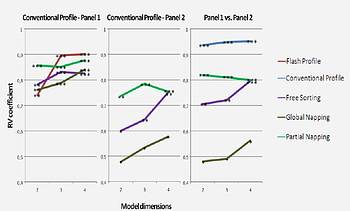Rapid Sensory Descriptive Methodologies in Practice – Do they really work?
C. Dehlholm1, P.B. Brockhoff2, L. Meinert3, M.D. Aaslyng3, W.L.P. Bredie1
1) University of Copenhagen, Department of Food Science, Denmark
2) Technical University of Denmark, Informatics and Mathematical Modelling, Denmark
3) Danish Meat Research Institute, Denmark
Introduction
An increasingly focus on rapid descriptive methodologies in sensory science has resulted in new methodologically approaches being proposed as well as a focus on their comparisons.
Aim
This presentation introduces a similar way of comparing methods that follow different concepts. Methods include Napping[1] and variations, Ultra Flash Profiling[1], Flash Profiling[2], Free Sorting[3] and conventional descriptive profile analysis. Results are based on a comprehensive Danish study performed by several groups of professional sensory panellists originating from two different research environments. Methods were applied on the same commercially available pâté products and in the same period of time.
Methods
Overall similarities are described by comparing RV coefficients applied at global configurations obtained from the different methodological approaches (Figure 1), while discriminability is examined within methods by superimposed ellipses of confidence achieved via bootstrapping techniques. Differences in semantic output are looked upon with regard to their holistic qualities and individual sample descriptions. Also, practical differences when performing different methods are described and suitable applications for the rapid approaches and their conceptual variations.

Results
While individual panels show differences in comparability between applied methods, these relationships are similar between panels (Figure 1). Comparisons of individual methodological configurations show best measures of reproducibility between panels for the conventional profile and the Partial Nappings. The semantic results show large variations according to the applied sensory methodology. The conventional method is reductionistic in attribute selection and provides easy interpretable results, while the free choice vocabulary based methods allow broader individual inputs, but challenging the analyst providing hundreds of attributes.
Conclusions
Are the rapid approaches worth their trade-offs? If sensory laboratories are only interested in products’ configurational distance, valid results can be obtained in half a day. If interests lie in the descriptive terminologies the choice of method will depend on, if laboratories need fixed, holistic or inspirational terms.
References
1. Pagès, J. (2003). Direct collection of sensory distances: application to the evaluation of ten wines of the Loire Valley. Sci. Aliments 23(5/6): 679-688
2. Dairou, V. & Sieffermann, J.-M. (2002). A Comparison of 14 Jams Characterized by Conventional Profile and a Quick Original Method, the Flash Profile. J. Food Sci. 67(2):826-834
3. Steinberg, D.D. (1967). The Word Sort: An instrument for semantic analysis. Psychon. Sci. 8(12):541-542